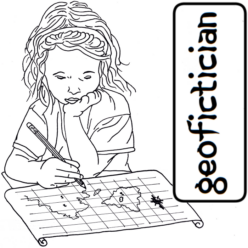“Conlanging” is the accepted name for the hobby of inventing new languages. I have been a conlanger since around age 7 – I remember inventing a language for my stuffed animals – specifically, a tribe of stuffed raccoons – at around that age, and though I don’t have my notes, I remember it being fairly sophisticated for something created at that age.
Like many conlangers, it’s only ever been a kind of side hobby, for me – though it dovetails nicely with another hobby I used to have as a child and that I resurrected in my post-cancer years and that has actually become a major avocation: geofiction (which is the whole point of the blog and website!). And of course, like many conlangers, I was, as a young adult, drawn to linguistics, where it eventually became one of my undergrad majors at the Univ of Minnesota. I don’t regret that, at all.
Anyway, this post is about conlanging, not geofiction. For some years now, there have existed some interesting websites and computer applications for inventing languages and storing the data. But I found a site yesterday that takes it to a new level. The site is called vulgarlang.com. I actually rather dislike the name, but I think it’s probably good marketing. Anyway, the site is created by people who clearly are quite knowledgeable on matters linguistic – to a level I’ve never seen before. I went ahead and paid the $25 “lifetime” access – we’ll see how that pans out, as I’ve seen many a website offering those terms that lasts 5-10 years before disappearing or radically altering its business model such that the guarantee doesn’t eventuate. But anyway, how could I resist. Let there be more conlanging, then – at a higher level of quality than ever before.
As an incidental, I haven’t posted much of my conlanging work online, at all, but a very incomplete exemplar can be found in this article about the Mahhalian language, which I created about 6 years ago originally.
